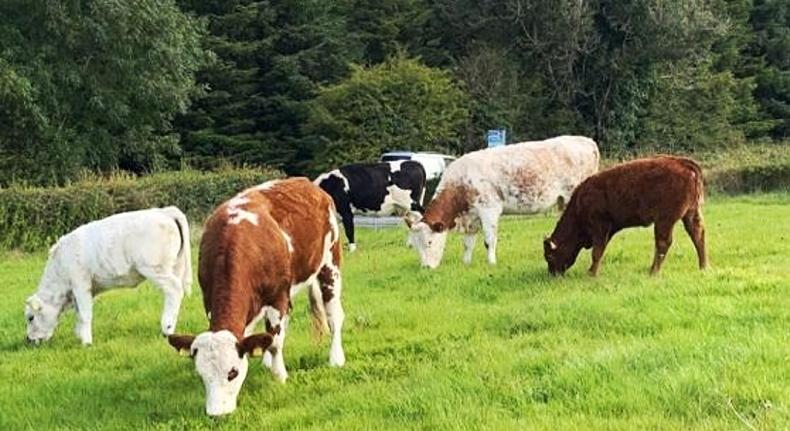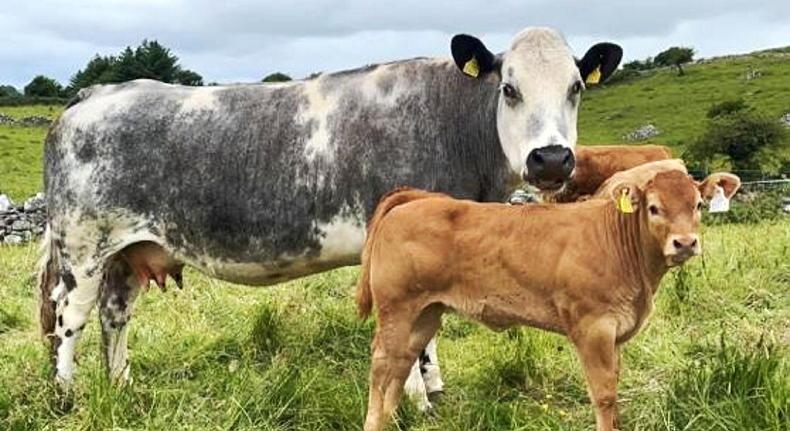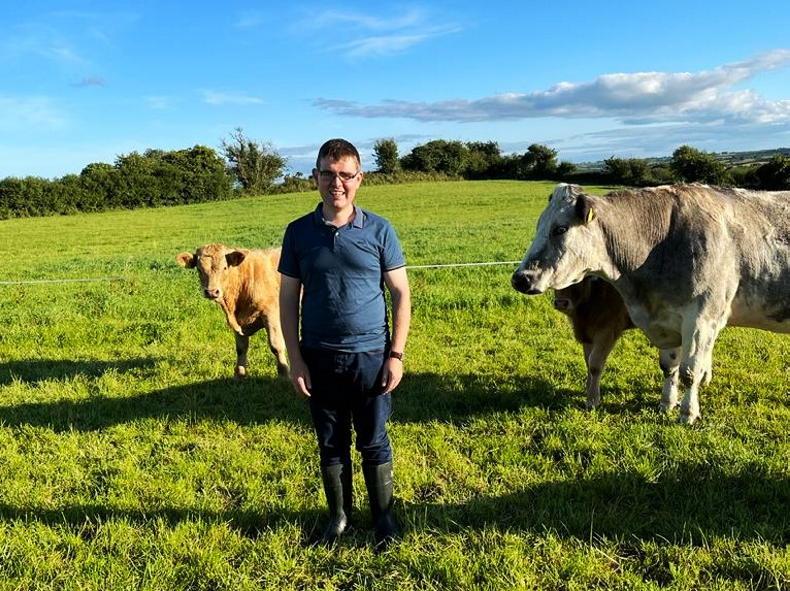Full-time farming, part-time teaching, that’s how I describe it anyway.” That’s how Mayo suckler farmer Alan Flatley classifies his occupation.
Farming near Kilkelly in the east of the county, the substitute secondary teacher has the best of all worlds at the moment.
“I’d like to be full-time but subbing has its bonuses with the farm.”
Farming with his father, Eugene, and running 25 suckler cows and store heifers on a land base of 45ha, the farm is typical of the area, very fragmented with various land types.
“It’s in seven or eight blocks, with some excellent limestone land up near Agahmore and other ground then, if it gets the smell of rain it would be soggy.
“We try to match cow type to the land. Some bigger cows would be on the better land and smaller, more compact cows spend their summers on the wetter ground. You couldn’t put a 900kg cow on ground where she’d sink to her belly.

Cows are calved from lat March to early May with bull weanlings sold later in the year.
“We wouldn’t be loyal to any one breed. There’s a few Blues, Charolais or Angus, but the majority would be first- or second-generation Shorthorn or Simmental. We’ve always gravitated back to those two as we’d like to have a cow that is well able to rear its own calf on more marginal ground.
“We try to avoid having too much calving issues too, so we use easy-calving sires.
“The last thing you want when you’re away from the farm is a call to say there’s a calf stuck at the hips. More often than not, they calve themselves. You might not hit the top prices with that weanling but you’re nearly making it back because there’s no issue getting her back in calf and less inputs and time involved.”

Replacement heifers are retained from the herd with an odd heifer that was brought in kept for breeding on occasion.
Bull weanlings are sold in the backend of the year from October onwards, with heifers targeted at the forward store trade. With the farm centrally located in east Mayo and with a good road network, there’s no shortage of mart options when it comes to selling.
“There’s plenty of choice around when it comes to marts. We’re equal distance to Balla, Ballina, Castlerea and Ballymote and then Roscommon and Elphin are that bit further away but still within the hour.”
Not that long ago, there was even more choice closer to home before rationalisation took place.

Alan calves his heifers later than cows so that they can get to grass sooner after calving as his ground is marginal in places.
“Swinford, Ballyhaunis and Claremorris all had marts but they’ve all closed. I’m 31 now but I’d remember going to those marts when I was younger.”
The Flatleys’ aim for their cows is to try to get them to have as close to 10 calves in their lifetime, if possible, but they don’t hesitate culling a cow if there’s any issue with feet, mastitis or temperament.
Replacements
Replacements are retained from within the herd but if a heifer catches the eye at the mart, they’re an option too.
“If we picked up a nice Shorthorn or Simmental heifer that was quiet and had the qualities we wanted in a cow, we’d keep her. It’s harder to source them. There’s a lot more competition with online bidding for the likes of those heifers.”
Alan tries to calve heifers close to 24 months but, sometimes, a few extra months are required. “If she spent a lot of her time on poorer ground, she could be 28 months. It can often be 1 May before you get out around here.”

Alan Flatley runs a suckler herd at Glann, Kilkelly, Co Mayo.
Calving usually begins in late March and runs to early May. Given the nature of some of the land he’s farming, Alan calves the heifers after the cows in order to get them to grass sooner after calving.
“We try to have the heifers towards the end of calving and have a group of them. Hopefully, they can get out straight away so they can get out to grass and let the calf hit the ground running.
“We’d use easy-calving bulls on the heifers. This year, we used the Angus bull Fargahl from Progressive Genetics on the heifers. We find the Angus is usually straightforward with no dehorning and they’re hardy too. They’re a great start for a heifer and there’s good demand from Angus crossed on sucklers. We sold a two-year-old Angus heifer from a first-calver earlier this year. She was 760kg, €1,940, so we’d be hoping for similar with this bunch of heifers calves.”
When he’s not farming or teaching, Alan can be found pitch-side covering GAA matches for the Western People newspaper and giving match updates on Midwest Radio. Ahead of other pundits, he put down the pen last year and had his first venture in management, taking the under-14 LGFA team at Sacred Heart School in Westport to a Connacht title. “I’ve been reporting on games for four or five years now. Usually it’s covering one of the local teams like Moy Davitts, Aghamore or Claremorris or whatever game is on locally. Most of the matches are in summer, so there’s no fear of it clashing with calving. It’s a nice break.”
Name and location: Alan Flatley, Glann, Kilkelly, Co Mayo.Farm: 45ha owned and rented.System: Suckler to weanling/store.Cow numbers/type: 25, Shorthorn and Simmental with some Angus, Belgian Blue and Charolais.Bull use: All AI – ZAG, Fiston, Lapon, Farghal.
Full-time farming, part-time teaching, that’s how I describe it anyway.” That’s how Mayo suckler farmer Alan Flatley classifies his occupation.
Farming near Kilkelly in the east of the county, the substitute secondary teacher has the best of all worlds at the moment.
“I’d like to be full-time but subbing has its bonuses with the farm.”
Farming with his father, Eugene, and running 25 suckler cows and store heifers on a land base of 45ha, the farm is typical of the area, very fragmented with various land types.
“It’s in seven or eight blocks, with some excellent limestone land up near Agahmore and other ground then, if it gets the smell of rain it would be soggy.
“We try to match cow type to the land. Some bigger cows would be on the better land and smaller, more compact cows spend their summers on the wetter ground. You couldn’t put a 900kg cow on ground where she’d sink to her belly.

Cows are calved from lat March to early May with bull weanlings sold later in the year.
“We wouldn’t be loyal to any one breed. There’s a few Blues, Charolais or Angus, but the majority would be first- or second-generation Shorthorn or Simmental. We’ve always gravitated back to those two as we’d like to have a cow that is well able to rear its own calf on more marginal ground.
“We try to avoid having too much calving issues too, so we use easy-calving sires.
“The last thing you want when you’re away from the farm is a call to say there’s a calf stuck at the hips. More often than not, they calve themselves. You might not hit the top prices with that weanling but you’re nearly making it back because there’s no issue getting her back in calf and less inputs and time involved.”

Replacement heifers are retained from the herd with an odd heifer that was brought in kept for breeding on occasion.
Bull weanlings are sold in the backend of the year from October onwards, with heifers targeted at the forward store trade. With the farm centrally located in east Mayo and with a good road network, there’s no shortage of mart options when it comes to selling.
“There’s plenty of choice around when it comes to marts. We’re equal distance to Balla, Ballina, Castlerea and Ballymote and then Roscommon and Elphin are that bit further away but still within the hour.”
Not that long ago, there was even more choice closer to home before rationalisation took place.

Alan calves his heifers later than cows so that they can get to grass sooner after calving as his ground is marginal in places.
“Swinford, Ballyhaunis and Claremorris all had marts but they’ve all closed. I’m 31 now but I’d remember going to those marts when I was younger.”
The Flatleys’ aim for their cows is to try to get them to have as close to 10 calves in their lifetime, if possible, but they don’t hesitate culling a cow if there’s any issue with feet, mastitis or temperament.
Replacements
Replacements are retained from within the herd but if a heifer catches the eye at the mart, they’re an option too.
“If we picked up a nice Shorthorn or Simmental heifer that was quiet and had the qualities we wanted in a cow, we’d keep her. It’s harder to source them. There’s a lot more competition with online bidding for the likes of those heifers.”
Alan tries to calve heifers close to 24 months but, sometimes, a few extra months are required. “If she spent a lot of her time on poorer ground, she could be 28 months. It can often be 1 May before you get out around here.”

Alan Flatley runs a suckler herd at Glann, Kilkelly, Co Mayo.
Calving usually begins in late March and runs to early May. Given the nature of some of the land he’s farming, Alan calves the heifers after the cows in order to get them to grass sooner after calving.
“We try to have the heifers towards the end of calving and have a group of them. Hopefully, they can get out straight away so they can get out to grass and let the calf hit the ground running.
“We’d use easy-calving bulls on the heifers. This year, we used the Angus bull Fargahl from Progressive Genetics on the heifers. We find the Angus is usually straightforward with no dehorning and they’re hardy too. They’re a great start for a heifer and there’s good demand from Angus crossed on sucklers. We sold a two-year-old Angus heifer from a first-calver earlier this year. She was 760kg, €1,940, so we’d be hoping for similar with this bunch of heifers calves.”
When he’s not farming or teaching, Alan can be found pitch-side covering GAA matches for the Western People newspaper and giving match updates on Midwest Radio. Ahead of other pundits, he put down the pen last year and had his first venture in management, taking the under-14 LGFA team at Sacred Heart School in Westport to a Connacht title. “I’ve been reporting on games for four or five years now. Usually it’s covering one of the local teams like Moy Davitts, Aghamore or Claremorris or whatever game is on locally. Most of the matches are in summer, so there’s no fear of it clashing with calving. It’s a nice break.”
Name and location: Alan Flatley, Glann, Kilkelly, Co Mayo.Farm: 45ha owned and rented.System: Suckler to weanling/store.Cow numbers/type: 25, Shorthorn and Simmental with some Angus, Belgian Blue and Charolais.Bull use: All AI – ZAG, Fiston, Lapon, Farghal.










 This is a subscriber-only article
This is a subscriber-only article










SHARING OPTIONS: